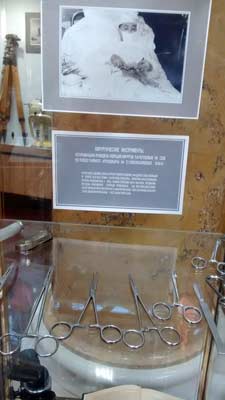That self-appendectomy
 Photos provided by Dr. Vladislav Rogozov (son of the surgeon/ patient Leonid Rogozov), used by special permission (see below) So here are the facts: it happened during 6th Soviet Antarctic Expedition at Novolazarevskaya Station. The patient was the only physician on station, so the assistant was a mechanic. It was on April 30, 1961. The operation took 2 hours. He positioned himself so that he could see his own body using a mirror when doing the surgery - he made a 12 cm cut through which he found the appendix. After 5 days the doctor felt good, and after 7 days he removed the wires which had been used to sew up the body. His name: Leonid Rogozov. He published a short note about this in the Soviet Antarctic Expedition Information Bulletin, no. 37, pp. 42-44, 1962. The above information was provided a while ago by Alex Zaitsev, the Russian exchange scientist and friend that I wintered with at Pole in 1977. When the bulletins were translated into English, they were compiled in volumes of ten issues; numbers 31-40 were put in Volume 4, so the English reference for Dr. Rogozov's note is Rogozov KI: Self-operation. Soviet Antarctic Expedition Information Bulletin 4:223, 1964, and here is my copy. Novolazarevskaya is at 70°S 11°E, set up in 1960-61 on rock (the Shirmacher Oasis) in Queen Maud Land, 50 miles inland from the ice edge. It was closed for a bit in 1992...but more recently it is more commonly known as Novo...the blue ice runway also used by tourist operations is a few miles to the southwest.
SURGICAL INSTRUMENTS
By which the operation was carried out by surgeon Rogozov on himself (because of a suppurative appendix) at station Novolazarevskaya 04.30.61.
Alex Zaitsev told me that a similar surgery happened another time, although he didn't have any information. But later, during the 1983-84 season, someone from his laboratory had an appendectomy during a traverse between Mirny and Dome C.... Credits...the 1962 paper was located by Dr. Ross Hofmeyr, the 2008 winterover physician at SANAE (archive of his April 2008 blog entry). Thanks, Ross! The photos you see here of Dr. Leonid Rogozov during the operation were provided courtesy of his son, Dr. Vladislav Rogozov. The long version of the gory story of the operation later appeared in the British Medical Journal in December 2009 (this is behind a paywall)--it is referenced in this March 2011 Atlantic Monthly article, which is available. That photo of the exhibit in the St. Petersburg museum was shared by Antarctic friend Michael Christensen (MC), who visited it on 20 April 2014. The translation of the placard is from Monty Myrtle, who wintered at Pole in 2009 and has been working at the American Embassy in Moscow since then. He has also visited this museum. MC also sent a photo of another museum exhibit--this Russian version of Big Red...it certainly looks like it might do the job, but I don't know about those Sorel-type boots--they are probably not in the clothing issue for Vostok. Here is the home page for that Russian State Museum, I guess their English home page is no longer around. More recently, Vladislav Rogozov was interviewed about his father's surgery for the BBC World Service program Witness,; the interview aired in May 2015. Here's the BBC page with that story, more photos, and links to the podcast. And even more recently, in the 31 March 2017 NPR program This American Life, Ira Glass discussed this case with Dr. Sean Roden, a NASA physician who worked at South Pole in the 2012-13 summer. |

